Pine Creek Gorge, photo from Wikipedia Commons, Commons licensing
I have been violating one of my basic principles. I have, gasp, been painting from photographs.
Pine Creek Gorge 2, 12 x 16″ Oil on board, 2008
I have all kinds of reasons to do so: the paintings are for a good charitable cause and are specifically tailored for an audience that will like the subject. I can’t get to the landscapes in the photos to paint them on-site (and besides, it’s cold outside). The subject matter of the photographs is of a place I grew up in, camped in, swam, hiked, and made love in – it’s a place I know intimately.
The area is in north central Pennsylvania, where the ice age shaved off the land, after which streams cut deep notches, through shale and tumbled rocks, to make cobblestone creeks. The specific subject is the Pine Creek Valley, with emphasis on the Pine Creek Gorge, above which my mother’s family farmed (and boarded loggers) and at the end of which (just below Cedar Run) my parents ensconced themselves in their later years. Pine Creek, always called Pine Crick by us locals, runs into the West Branch of the Susquehanna about 100 miles above Harrisburg, near Jersey Shore, Pennsylvania; it is the Jersey Shore High School class of 1960, raising scholarship funds for students, for whom I am doing the paintings.
So doing the work has me somewhat ambivalent: the cause is good; the available photos quite satisfactory, and the subject matter entirely visceral, even from someone else’s photos. But it’s still painting from photos.
Little Pine Creek Dam, Photo by Charlie Bierly, used by permission
LIttle Pine Creek in Snow, 12 x 16″, Oil on board, 2008.
There were other elements, also, that keep me going. At first I was enticed by the greens, which I remember almost viscerally. These greens are specific to this district, or so it seems to me, having compared them to greens in the Alleghenies proper, the Virgina blue mountains, the Rockies near Laramie and Denver, and western Oregon, where green can smother you. These Pine Creek greens are a different blend of hard-and-soft wood, of limes and lemon greens, avocado and olive hues, sap and davys and veridian paints.
I did some palette studies of greens and then painted (and repainted, and reworked, and painted again) four 12 x 16″ paintings of the Gorge itself.
Pine Creek Gorge 3, 12 x 16″ Oil on board, 2009.
I grew a bit bored with green (although I found other variations on the hue as I worked elsewhere) and for a while, consoled myself with tumbling water – rather like painting hair, in fact.
Turkey Track Trail Waterfall, 12 x 16″, Oil on board, 2008
But in my head, I could always hear that inner critic of my imagined, yet quite imaginable critic. I name him my Brother-in-law, but he is, really, just the voice in one’s head.
Painting from photos means painting from real places, places that other people have grown up in and camped, canoed, swam, and even, perhaps made love in. They not only know what it looks like, but many of those who will be seeing and judging the paintings will know the Gorge better than I can know it. They will never have left the area, whereas I haven’t lived there for forty years. So I can hear, in my head, my BIL saying, “That mountain over there is really further away. And where’s the cut for Bear Run? What kind of tree is that, anyway?”
I suspect, although I have no evidence to back this up, that the primary audience for these paintings will be people who may not have had much visual art training (I certainly didn’t while I lived there) but will know the land because they’ve hunted deer and bear and turkey and hiked and camped and biked it for 40 more years than I did.
It’s hard to know if this audience will see my brush strokes or lovely variations in color. Maybe they will only see where I’ve messed up some specific feature.
A further complication is the photos themselves. They were taken by a classmate in the last few years; he rode a rail-to-trails bike path up Pine Creek; the rails-to-trails path runs on the old railroad line, which was on the other side of the creek, the east side, from where I spent most of my growing up. It also ran up the Gorge rather than across the tops of the west rim of the mountains where the logging and CCC fire roads were that we drove around on. So the views in the photos are ever so slightly askew from the views that I remember – not enough to make me refuse them, but just enough to make me uneasy with what I’m depicting. The unknown memories lie there, kicking at me, when I see the Crick bend the wrong way.
Tree and Crick 1, 12 x 16″, Oil on board, 2008
Photos also don’t quite have the detail that I want – they have detail, of course, and more than I’m willing to paint, for the most part, but they don’t have the detail I want to paint. And that’s because in general, my eyes see differently than cameras do. I’m not much interested in the monocular, totally stable viewpoint (what I called, to Jay’s dismay) the “postcard view,” of scenes. Multi-ocular, multi-stance, on the fly, just at the moment of movement – that’s what I see and what I like to try to capture in my ‘scapes.
Duck in Flight, 12 x 16″, Oil on board, 2008
So ambivalent I remain. To be “true” to my style, I could easily dismiss the concerns of my audience, who then might not spend money on the paintings — which would nullify the entire reason for doing the work. On the other hand, to be totally true to my audience might, for me, be impossible.
I now have something like 12 paintings of the Pine Creek Valley. I have a couple more realistic ones to do. But I think then, I’m going to head out for something that will come out of the paintings (I’m thinking green, or maybe layers of hillocks) but which will be abstracted and seriously weird, so weird no one will mistake it for anything but intentional. Maybe arbitrary color will be my first attempt. And I know I want to do those hills like Grant Wood’s landscapes or foliage like Charles Burchfield.
So I’m compromising, seriously, and in matters about which I normally don’t compromise. I said, almost seriously, that I would never paint exclusively from a photo and in fact turned down a lucrative commission (from a quite drunken fellow, I’ll admit) to do so.
But here I am, compromising to the tune of many paintings, for the sake of – of what? A good cause, of course. And reconnecting with fellow classmates. And making something of a brag about where I’ve been since 1960. And finally, perhaps, I’m painting from photos simply because doing these paintings was a challenge, issued in a rather slow time of art-making for me, a time when painting from photos was a release from the guilt of not braving the almost tolerable Portland weather.
Shale Shelf, Pine Creek Valley, 12 x 16, OIl on Board, 2008
Have you, are you, making compromises? Or under what circumstances would you do do? Would you compromise, for example, your desire for a particular composition in order to explore a particular color, like “green.” And how uneasy to you have to feel before you draw the line?
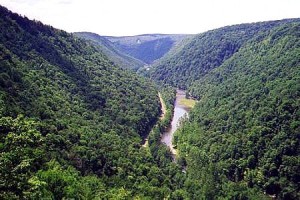
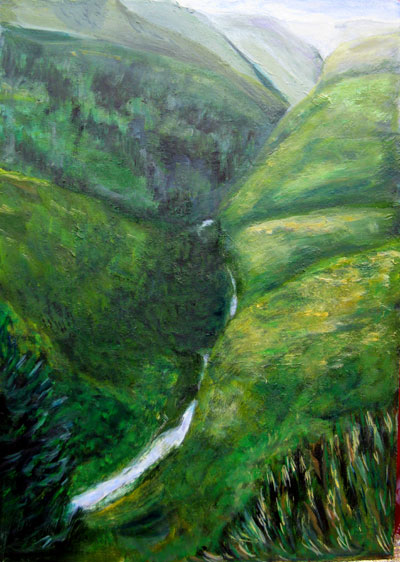
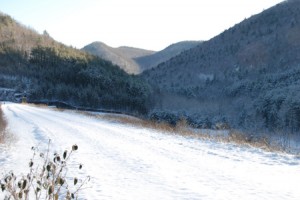

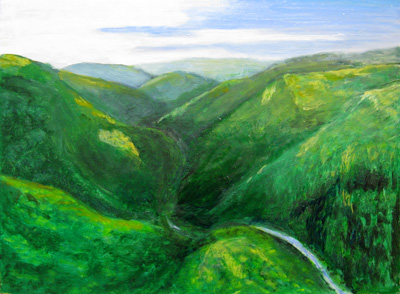

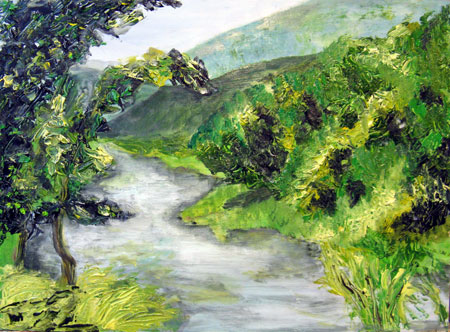
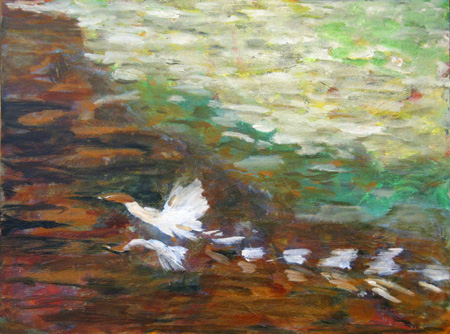


“LIttle Pine Creek in Snow” and “Tree and Crick 1” are my favorites: a bit wild and uncertain. Painted.
Hi D. —
Thank you for the insights.
I wonder if I could have guessed that those would be your favorites.
One gets to know one’s audience, after a time. In fact, I have a meeting with my painting critique group tomorrow evening, and I have nothing to show them, in spite of the fact that I’ve been painting like a fury. I’ll have to take one or more of these paintings, and suffer.
They will all be appalled at what I am doing (painting conventional landscapes from _photos_!!!! They’ll be polite and nice and kind and gentle, but they really will shake their heads behind my back. They are, generally speaking, long established abstract painters, interested in landscape only if you have to guess that that’s what it is. I might have to run up an abstract this evening, just to avoid the pity (add that snort here). It’s not that they are judgmental or difficult, but they have their standards, even when they try to hide them.
but from you, I accept the gentleness and don’t even begin to think you might be shaking your head……
June,
I love the composition of Tree and Crick, with opposite banks talking with each other, and also your typical active landscape-as-a-living-body as in Pine Creek Gorge 3 and Turkey Track Trail Waterfall.
As for your abstract-inclined fellows, just show them your paintings upside-down. I think they hold up quite well that way.
I haven’t had much opportunity for compromise fo the sort you’re wondering about, not being knee-deep in commissions. I did donate a couple of Sourdough Trail images to a local environmental organization for reproduction in modified form in membership mailings. They did a fine job and it served the purpose, so I don’t intend to be bothered by the fact that the presentation wasn’t what I’d do myself. As long as I can also do it my own way elsewhere.
A thought: Why should artists be less expected to compromise than anyone else in their dealings with the world?
June,
To round it off, I can tell you that my favorites are Pine Creek Gorge 2 and Duck in Flight, in that order. Now, all of your pictures have excited someone.
Pine Creek Gorge 2 is powerful. It does not look monocular at all. Thus, it is what you bring to it, the photograph just serving as a reminder of the major outlines of a motif.
And the ducks, I am partial to reflections.
From looking at your pictures, I assume that the trick is to convert the depiction of a landscape from the ‘monocular’ look of the photograph to a more natural 3-D view. The recipes seems to be (1) doing some pleine air painting to get a sense of 3-D and (2) knowing the motif of the photograph ‘viscerally’.
I am reminded of a time when I was learning to draw from a live model. Most of the class was obsessed with any movement the model might make (“Hey. Lift your right elbow. More. More. More. Back…). It was ridiculous. I responded by slowly rotating my paper while I continued to draw. The guy next to me (later I learned it was Lawrence Ferlinghetti) was amused. We liked the results.
And Turkey Track Trail Waterfall is absolutely wonderful. How did I miss it.
Hi Steve,
Thanks for the “talking to each other” insight. Oddly, I hadn’t thought of that painting in that way and now I like it even more. Like D. I like the painterliness of some of the pieces. There’s something delicious about all that gooey glop.
My abstract minded fellows were not just kind, but insightful. The best comment came from one whom I respect perhaps the most, although each of the painters in the group has his/her strengths and insights. But the comment that caught me most fully was one which said, “these are very nice; but they aren’t you. It’s fine to do them, and wonderful that you are helping out a good cause, but get back to your wonky urban-and-land-scapes as soon as possible. Don’t let yourself get too distracted. Lots of people can do this kind of work, but only Underwood sees buildings the way you do.”
He didn’t say it quite that way, and was really worried that he might offend me, but on the contrary, I felt affirmed about the paintings that I really love doing — those plein air, caught-on-the-fly, view from the crooked eye, scapes. So my slightly cranky remarks about my fellows in the critique group were entirely off base. I think it was my BIL talking.
And about compromise — I suspect part of my worry about it is that it’s seductive to paint from nicely composed photos — you can always blame the photographer if the painting stinks, eh? snort, of course. So I call it making compromises, but I really fear losing something that I value — that something, whatever it is, that makes us go out in the cold and wind and continue to press to understand what we see and produce it so others can see it too. Much easier to sit in the warm studio and paint from something someone else braved the elements to produce.
Birgit,
“Rounding off” made me smile — and Ducks in Flight has been a blessed relief from Green and from layered mountains. It also has been something of a challenge. The reflection was the easy part, mostly because it was already in the photo and copying it wasn’t a problem. The real problem was the angle of the photo which gave me nothing but the ducks as a reference point — the rest is water and rocks, some of which are under quite a bit of water and some of which reflect greenery on the shore and some of which are out of water, dry, and so don’t reflect anything. It’s all quite a muddle and occupies 3/4 of the painting. So my updated version attempts to clarify some of the muddle but also to lead the eye around the painting, not keep it stuck on the ducks. We’ll see if it succeeds.
Thanks for your comments and insights.
You are quite right that the trick is to see viscerally — or it is for me, at any rate. Some of the sights, of course, are tricky. I was 2 or 3 feet shorter and considerably less round when I was looking regularly at these mountains and moreover had never been west of Columbus Ohio nor east of Syracuse New York. The mountains were the biggest things I’d ever seen. So they still have a trace of that ignorant child’s eye view, I’m afraid.
D —
I too have been puzzled by the exactitude with which fellow artists have measured where the model’s thumb was after every break. I attributed it to my own ineptitude — no Ferlinghetti to urge me on in my wayward ways. But you may be passing along the legacy.
“Turkey Track Trail Waterfall” is a title I can’t resist — and can’t say quickly, either. Someone blogged about walking down the Turkey Track Trail from the top of the ridge, getting caught in a downpour, and having to scramble back up it. The mountains look gentle and benign, but because I too have scrambled up one or more of their sides, I can vouch for the steep, brambly, muddy, scree-filled niceties. Here’s the blogger’s URL — I can’t remember how to turn it into a nice link: http://beebalm.wordpress.com/2008/06/30/pa-wilds/
thanks for liking the waterfall. I did another, but it isn’t as curly.
June, I’m struck by your comment “So they still have a trace of that ignorant child’s eye view, I’m afraid.”
Coincidentally, I’m reading Twyla Tharp’s marvelous book The Creative Habit and just finished the chapter “Skill” — in which she talks about trying to maintain two states of mind — the wisdom of experience and the fearlessness of naivete — and also cites Musashi’s A Book of Five Rings: “Never have a favorite weapon.”
It may be that, having taken this side trip into a good cause, you will return to your more natural interests with something you didn’t know you’d found. There’s a different kind of confidence in these paintings, a kind of — I’m not sure what, ease or purity or forthrightness — than isn’t as present for me in your urbanscapes. I don’t think it’s simply because of copying “nicely composed photos” but perhaps from being able to do it with furious facility. . . ?
I wonder if there might be something fruitful in taking up Steve’s almost-suggestion of abstracting from here? Shale Shelf, in particular, feels to me as though it’s on the brink of something profound that might coalesce through abstraction. (bias alert: my fondness for rocks is blatantly Druidical)
I’m not articulating this well, but I found these paintings very moving (although I know I’m not supposed to). That “ignorant child’s view” may the crux of the thing.
June:
You don’t get back to Pine Creek much anymore, right? Seems it would be interesting to see what an easel powered take on your old ancestral hunting grounds would be like. I can remember a trip up to the edge of the gorge to visit a run down house in an overgrown field that had been home to some of your relatives: a lush setting if I remember. It would seem that the glories of Pa. remain with you regardless of the misbegotten, misshapen, pernicious and plain pug ugly influences of dire Oregon.
Melanie,
Thank you for your insights. They are valuable and I’m going to stash them close by. Tharp’s comments about “the wisdom of experience and the fearlessness of naivete” rings very true to me. In fact, I suspect one ofmy strongest points of personality is a that kind of fearlessness that comes from ignorance — not knowing, until I’ve been sucked in, just how bad those rapids are it is that I’m about to attempt to run.
My urban-scapes are more jittery, a bit more “unsure” or tentative, in part because of the circumstances under which they are being produced. Painting in the city has all kinds of adventures and trials which my studio lacks. I think that’s why I like it. Being a bit on edge is far more exciting than watching TV — or even painting in a nicely controlled environment — and I like a certain amount of this kind of “excitement.” But it’s also comforting to return to warm, quiet, thoughtful and stable painting situations.
I will play around with the abstraction possibilities — abstraction is far more challenging to me, in the holistic sense, than my representational work. It takes an inner clarity about what I’m doing or where I’m going or why I’m painting what I’m painting that requires insights hard to acquire and hold.
I could probably rank my working processes from easiest — painting from photos — to harder — painting urban-scapes plein air –to hardest — painting abstractions, whether abstracted from reality or totally mind-deduced. I like to move around within these comfort zones for the same reason I like going from the studio to the street — changing the environment keeps me fresh and excited about my work, while not stressing me to the point of giving up.
Jay —
Watch your tongue when you speak of Oregon. I’ve lived in Portland longer than I lived anywhere else, and I’m definitely a left-coast loyalist! Besides, the sun is shining and it’s proposed that it might get up to 50 degrees today. I don’t believe the latter, but the thought of it is a bit thrilling.
I haven’t been back to the Pine Creek Valley in at least 10 years — the last time was with my sister, in a snow storm that required that we stop at a number of watering holes to chain up, fuel up, eat up, and so forth. The scene, January in the fresh snow, was fairly magical, I’ll admit.
I would love to go back and paint, both the landscape and something of the small town where I went to high school. I think looking with a painterly eye at those old river-town buildings (what’s left of them) where my relatives lived and partied and died (and where my daughter was born) would be fascinating.
I don’t know if I could persuade Jer to leave his Wikipedia work long enough to get there; and I also don’t know if high speed internet has yet reached the wilds of the Pine Creek Valley. But maybe, someday (she said wistfully….)
Your trip memory almost certainly was to the Old Camp (across from Tiadaughton, on the west rim of the gorge) where my mother’s family farmed and fed loggers. And where I really established my memories of the landscape (as well as my distaste for rattlesnakes).
June:
Bid Jer fear not. Wellsboro awaits at the head of the gorge, and in it the Penn Wells Hotel.
June,
I like what you said about abstraction: ‘It takes an inner clarity about what I’m doing or where I’m going or why I’m painting what I’m painting that requires insights hard to acquire and hold’.
And, I do hope that you will return to the haunts of your childhood to paint what is there. I has meant a lot to me to return to my German hometown so frequently at recent times to breathe the North Sea air and look at the mudflats and rich, green meadows.
June, I absolutely love some of your paintings.
When I first begun to paint, I loved greens and your paintings just reminded me why I did. So tell me, what is the key to mixing these great shades of green and be consistent all the time?
Hi Linnette,
I’m not sure I have a secret: I use a lot of sap green as my basic green, but did the viridian studies just before I began these paintings, so that may have influenced me. Also I have a pigment called Perylene black that goes green when mixed with medium or white — a blue-green, that I use a lot for darker areas.
Maybe the key is having grown up with greens and living in Portland, Oregon, where one always deals with green. And more green.
I’m keenly aware of green right now because I just returned from the desert where the operative colors were beige. What a variety of beiges there are!!!